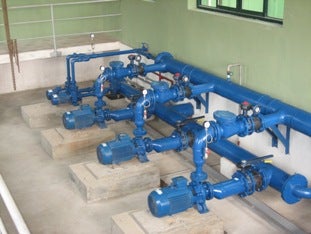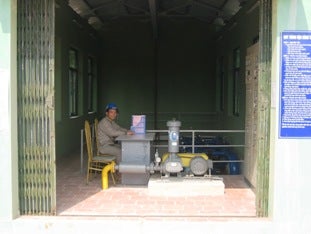New Investment Offers Reliable Water Supply in Vietnam
 The 12,500 inhabitants of Lim Town and part of nearby Noi Duc commune in Bac Ninh Province of Vietnam have seen great changes in their water supply as the result of an innovative Design-Build-Lease (DBL) water project developed through PPIAF-funded technical assistance.
The 12,500 inhabitants of Lim Town and part of nearby Noi Duc commune in Bac Ninh Province of Vietnam have seen great changes in their water supply as the result of an innovative Design-Build-Lease (DBL) water project developed through PPIAF-funded technical assistance.
In a January 2009 field trip to the project about 40 kilometers from Hanoi, PPIAF met with the private sector DBL contractor who outlined how over 90% of the households in this pilot area have already signed up for connections providing reliable piped water supply. Previously households had relied on shallow wells which drew on increasingly polluted groundwater.
This project tested the viability of involving the private sector to help provincial water companies, nominally responsible for serving provincial towns, provide water services to the many communities in Vietnam that lack any form of piped water supply.
The PPIAF-funded assistance drew on earlier work on the DBL model in the Philippines and developed a financially sustainable, customer-focused approach to service delivery through a single DBL contract (for a 12-year contract period: up to 2 years for design and construction followed by a 10 year lease period), with the successful contractor selected through a competitive bidding process.
 Critical to the approach was the involvement of the community, along with the local People’s Committee and the provincial water company, in designing and implementing the project. The construction was funded by a grant from the Swiss Agency for Development and Cooperation.
Critical to the approach was the involvement of the community, along with the local People’s Committee and the provincial water company, in designing and implementing the project. The construction was funded by a grant from the Swiss Agency for Development and Cooperation.
The contractor has employed 14 local full-time operational staff as well as several part-time for meter reading and billing. Already around 2,300 households have been connected in a little over a year of operation and further take-up to 2,500 is expected.
A parallel DBL pilot has also been successfully implemented in Minh Duc Town near Haiphong. The initial DBL system has already risen from 1,350 to 2,000 household connections and further expansion to around 3,000 is likely over the next few years. A similar number of new jobs to those in the Lim Town pilot have been created.
Both the Lim and Minh Duc contractors report that women are the major drivers of increased take-up and consumption for household uses; clinics, schools and other public services have also clearly benefited.
